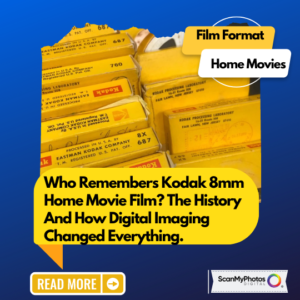[Read Time: 2.9 minutes]
Kodak 8mm home movie film played a significant role in the history of amateur filmmaking and home movies. Developed by Eastman Kodak Company, 8mm film was introduced in 1932 as an affordable and accessible format for capturing moving images. It quickly gained popularity among consumers and became one of the most widely used film formats for home movies.
Kodak 8mm Home Movie Film: A Journey Through Time.
 Dive into the captivating history of Kodak 8mm home movie film and discover how ScanMyPhotos.com’s cutting-edge scanning technology can bring your precious memories to life. Learn about their unique process, including frame-by-frame scanning for sharing on social media and creating stunning photo enlargements.
Dive into the captivating history of Kodak 8mm home movie film and discover how ScanMyPhotos.com’s cutting-edge scanning technology can bring your precious memories to life. Learn about their unique process, including frame-by-frame scanning for sharing on social media and creating stunning photo enlargements.
<< How to get digital copies from 8mm Kodak home movie film
Here is a brief history of Kodak 8mm home movie film:
Introduction of 8mm Format: In 1932, Kodak released 8mm film as an alternative to the larger 16mm format used in professional filmmaking. The smaller 8mm film allowed for more compact cameras and made it easier for amateurs to use.
Initial Success: The introduction of 8mm film opened up new possibilities for people to capture their everyday lives on film. Due to its affordability and simplicity, it became immensely popular among families and amateur filmmakers.
Evolution of the Format: Kodak introduced various improvements and advancements to the 8mm format over the years. In 1935, Kodak released a Double 8mm film with twice the amount of film on a single reel, allowing for longer recording times. In 1965, Kodak introduced Super 8mm film, which featured smaller sprocket holes and improved image quality.
Availability and Accessories: Kodak made 8mm film widely available, and it could be purchased in different lengths, such as 25 feet, 50 feet, or 200 feet, to suit various recording needs. The company also offered a range of accessories, including projectors and editing equipment, to support the entire filmmaking process.
Popularity and Cultural Impact: The accessibility and affordability of 8mm film made it a popular choice for capturing family vacations, special occasions, and personal memories. The format allowed ordinary people to become filmmakers and document their lives in a way that was not possible before. 8mm home movies became cherished family keepsakes, providing a window into the past for future generations.
Transition to Digital: With the rise of digital technology in the late 20th century, the use of film began to decline. The convenience and ease of digital video recording and editing led to a significant shift away from traditional film formats, including 8mm. Kodak discontinued the production of 8mm film in the early 2000s as digital formats became the dominant medium for home videos.
ScanMyPhotos: Preserving Memories for the Digital Age.
Our home movie film archival service offers a comprehensive solution for preserving cherished 8mm movie film memories in the digital age. The advanced technology and expertise ensure that these precious films are digitized and safeguarded for future generations. Utilizing high-quality scanning equipment, ScanMyPhotos meticulously captures each frame of the 8mm film, preserving the original content with remarkable clarity. We employ professional technicians who handle the movie with the utmost care, ensuring the delicate reels are protected throughout digitization.
<< How to get digital copies from your 8mm and 16mm home movie film reels.
Four reasons why archivists and family historians are celebrating Spielberg’s new film.
Today, while 8mm film is no longer widely used, it holds a nostalgic place in the history of filmmaking. Many people still cherish and preserve their old 8mm home movies, and the format continues to be appreciated for its unique aesthetic qualities.



